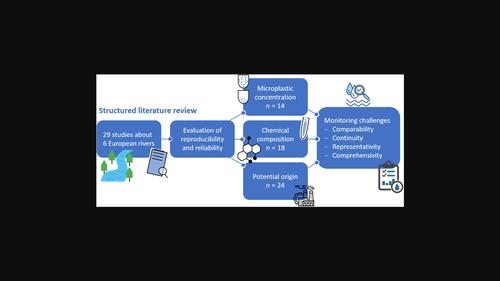A review on microplastics in major European rivers
引用次数: 0
Abstract
The topic of riverine microplastics is of great interest to the general public, yet the univocal scientific knowledge on this topic is limited. This review investigated the occurrence of microplastics in 6 major European rivers and their tributaries based on the results from 29 studies. We examined the reviewed studies in regard to data quality and reproducibility and assessed the abundance of microplastics in different sections of the water column. Furthermore, we investigated the chemical composition and potential origin of the reported riverine microplastics. We found that polystyrene, polypropylene, and polyethylene were the most abundant polymer types. The majority of primary microplastics arose from the industry sector as well as from personal care and cleaning products, whereas secondary microplastics constituted fibers from synthetic textiles and fragments of diverse origins. We highlighted the diversity of experimental and analytical approaches that could lead to high uncertainties in the measurements of microplastics abundance. Furthermore, the presence of microplastics in rivers was found to vary spatially likely due to point and nonpoint pollution sources of anthropogenic activities. Heterogenous environmental processes impacted the fate of microplastics characterized by various forms, sizes, and densities, in different ways. This impeded the identification of representative quantitative measurements of microplastics across different time frames. We advocate for the development of standardized protocols by the research community to ensure higher reproducibility of sampling, processing, and analysis of microplastics in aquatic environments. We recommend long-term and site-specific monitoring on microplastics with high data comparability to better inform policy making.

欧洲主要河流中的微塑料综述
河流中的微塑料是公众非常感兴趣的话题,但有关这一话题的统一科学知识却很有限。本综述基于 29 项研究的结果,调查了欧洲 6 条主要河流及其支流中微塑料的发生情况。我们从数据质量和可重复性方面审查了所审查的研究,并评估了微塑料在水体不同部分的丰度。此外,我们还调查了所报道的河道微塑料的化学成分和潜在来源。我们发现,聚苯乙烯、聚丙烯和聚乙烯是含量最高的聚合物类型。大部分原生微塑料来自工业部门以及个人护理和清洁产品,而次生微塑料则由合成纺织品的纤维和不同来源的碎片组成。我们强调了实验和分析方法的多样性,这可能会导致微塑料丰度测量的高度不确定性。此外,我们还发现河流中微塑料的存在存在空间差异,这可能是由于人为活动的点污染源和非点污染源造成的。不同的环境过程以不同的方式影响着以各种形态、大小和密度为特征的微塑料的命运。这阻碍了对不同时间段内具有代表性的微塑料进行定量测量。我们提倡研究界制定标准化方案,以确保水生环境中微塑料的取样、处理和分析具有更高的可重复性。我们建议对微塑料进行长期的、针对具体地点的监测,以提高数据的可比性,从而更好地为政策制定提供信息。
本文章由计算机程序翻译,如有差异,请以英文原文为准。
求助全文
约1分钟内获得全文
求助全文

 求助内容:
求助内容: 应助结果提醒方式:
应助结果提醒方式:


